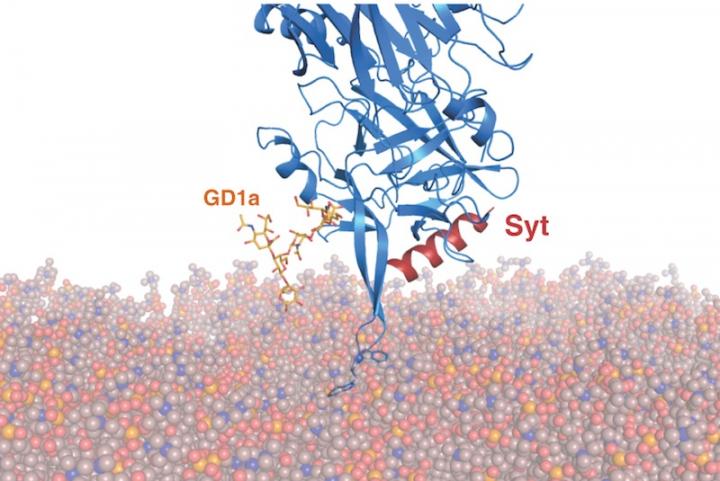Building a better botox

A genetically enhanced botulinum toxin B attaching to the nerve-cell surface via an engineered lipid-binding loop (blue), together with binding to two receptors (GD1a and hSyt1). Credit: Yin L; et al. PLoS Biology 2020 Mar 17; 10.1371/journal.pbio.3000618.
Botulinum toxins — a.k.a. botox — have a variety of uses in medicine: to treat muscle overactivity in overactive bladder, to correct misalignment of the eyes in strabismus, for neck spasms in cervical dystonia, and more.
Two botulinum toxins, types A and B, are FDA-approved and widely used. Although they are safe and effective, the toxins can drift away from the site of injection, reducing efficacy and causing side effects.
New research at Boston Children's Hospital finds that some small engineering tweaks to botox B could make it more effective and longer-lasting with fewer side effects. The findings were reported today in PLOS Biology.
A third way for botox B to bind to nerves
Botox works by attaching to nerves near their junction with muscles, using two cell receptors. Once docked, it blocks release of neurotransmitter, paralyzing the muscle.
Min Dong, PhD, at Boston Children's, with lab members Linxiang Yin, PhD, Sicai Zhang, PhD, and Jie Zhang, PhD, had been looking for ways to get botox B to bind to nerve cells more strongly, to keep it in place and avoid side effects.
In another member of the botox family, type DC, they identified a potential third means of attachment: a lipid-binding loop capable of penetrating lipid membranes.
Through structural modeling studies, they discovered that when particular amino acids are at the tip of the loop, the toxin can indeed use the loop to attach to the nerve-cell surface, in addition to binding to toxin receptors.
They further found that although botox B contains this same lipid-binding loop, it lacks these key amino acids at its tip. So Dong and colleagues added them in through genetic engineering.
As hoped, the introduced changes enhanced the toxin's ability to bind to nerve cells. In a mouse model, the engineered toxin was absorbed by local neurons around the injection site more efficiently than the FDA-approved form of botox B, with less diffusion away from the injection site. This led to more effective local muscle paralysis, longer-lasting local paralysis, and reduced systemic toxicity.
“Based on our mechanistic insight, we created an improved toxin that showed higher therapeutic efficacy, better safety range, and much longer duration,” says Dong. “The type A toxin does not have the lipid-binding loop, so we are still working on engineering this lipid-binding capability into type A.”
###
Boston Children's Hospital has filed for a patent and hopes to bring the enhanced toxin into clinical development.
Pål Stenmark of Stockholm University is co-senior author on the paper. The work was supported by the National Institutes of Health (R01NS080833, R01AI132387, R01AI139087, and R21NS10615), Ipsen Inc, the NIH-funded Harvard Digestive Disease Center (P30DK034854), Boston Children's Hospital Intellectual and Developmental Disabilities Research Center (P30HD18655), Harvard Center for Glycoscience, the Burroughs Wellcome Fund, the Swedish Research Council (2014-5667), the Wenner-Gren Foundation, and the Swedish Cancer Society.
About Boston Children's Hospital
Boston Children's Hospital is ranked the #1 children's hospital in the nation by U.S. News & World Report and is the primary pediatric teaching affiliate of Harvard Medical School. Home to the world's largest research enterprise based at a pediatric medical center, its discoveries have benefited both children and adults since 1869. Today, 3,000 researchers and scientific staff, including 8 members of the National Academy of Sciences, 21 members of the National Academy of Medicine and 12 Howard Hughes Medical Investigators comprise Boston Children's research community. Founded as a 20-bed hospital for children, Boston Children's is now a 415-bed comprehensive center for pediatric and adolescent health care. For more, visit our Discoveries blog and follow us on social media @BostonChildrens, @BCH_Innovation, Facebook and YouTube.
Media Contact
More Information:
http://dx.doi.org/10.1371/journal.pbio.3000618All latest news from the category: Life Sciences and Chemistry
Articles and reports from the Life Sciences and chemistry area deal with applied and basic research into modern biology, chemistry and human medicine.
Valuable information can be found on a range of life sciences fields including bacteriology, biochemistry, bionics, bioinformatics, biophysics, biotechnology, genetics, geobotany, human biology, marine biology, microbiology, molecular biology, cellular biology, zoology, bioinorganic chemistry, microchemistry and environmental chemistry.
Newest articles

Properties of new materials for microchips
… can now be measured well. Reseachers of Delft University of Technology demonstrated measuring performance properties of ultrathin silicon membranes. Making ever smaller and more powerful chips requires new ultrathin…

Floating solar’s potential
… to support sustainable development by addressing climate, water, and energy goals holistically. A new study published this week in Nature Energy raises the potential for floating solar photovoltaics (FPV)…

Skyrmions move at record speeds
… a step towards the computing of the future. An international research team led by scientists from the CNRS1 has discovered that the magnetic nanobubbles2 known as skyrmions can be…





















